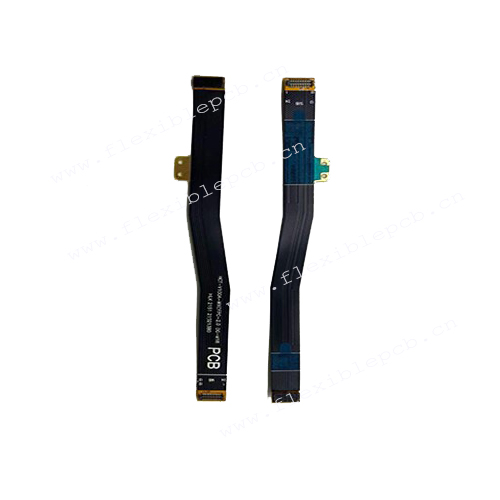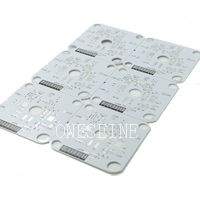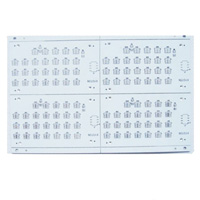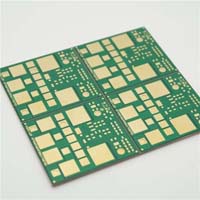Printed Circuit Boards
Dupont FPC 4 layer flex pcb stackup circuit board
- Dupont FPC
- flex circuit design
- flex pcb manufacturing
- rigid flex circuit boards
- Product description: transparent flex pcb transparent flexible pcb transparent fpc mobile FPC 2 layer flex pcb stackup 4 layer flex pcb stackup 6 layer rigid-flex stackup flex pcb thickness würth rigid flex stacku
Dupont FPC 4 layer flex pcb stackup circuit board
Application field: Handheld terminal products such as mobile phones, three defense devices, etc
Material: DuPont adhesive free rolling material
Plate thickness: 0.15mm
Process capability: impedance, high bending
Basic knowledge of flexible circuit boards
Introduction to FPC
FPC: Full English Pinyin Flexible Printed Circuit, which means flexible printed circuit board in Chinese, abbreviated as flexible board. It is a conductive circuit pattern made by using optical imaging pattern transfer and etching techniques on a flexible substrate surface. The surface and inner layers of double-sided and multi-layer circuit boards are electrically connected through metallized holes, and the surface of the circuit pattern is protected and insulated with PI and adhesive layers.
Mainly divided into single panel, double-sided board, multi-layer board, and soft hard combination board.
Characteristics of flexible circuit boards
1. Short: Short assembly time
All lines have been configured, eliminating the need for redundant cable connections;
2. Small: The volume is smaller than that of a PCB (hard board), which can effectively reduce the product volume and increase the convenience of carrying;
3. Lightweight: Lighter than PCB (hard board), it can reduce the weight of the final product;
4. Thin: Thicker than a PCB (hard board) can improve flexibility and enhance assembly in three dimensions within a limited space.
Advantages of flexible circuit boards
Flexible printed circuit boards are printed circuits made of flexible insulating substrates, which have many advantages that hard printed circuit boards do not have:
1. It can be freely bent, wound, folded, arranged according to spatial layout requirements, and moved and expanded freely in three-dimensional space, thus achieving the integration of component assembly and wire connection;
2. The use of FPC can greatly reduce the volume and weight of electronic products, which is suitable for the development of electronic products towards high-density, miniaturization, and high reliability. Therefore, FPC has been widely used in fields or products such as aerospace, military, mobile communication, laptops, computer peripherals, PDAs, digital cameras, etc;
3. FPC also has advantages such as good heat dissipation and solderability, easy assembly and low overall cost. The design of combining soft and hard also partially compensates for the slight deficiency of flexible substrates in component bearing capacity
FPC Main Raw Materials
Its main raw materials include: 1. substrate, 2. covering film, 3. reinforcement, and 4. other auxiliary materials.
1. Substrate
1.1 Adhesive substrate
1.2 Adhesive substrate mainly consists of three parts: copper foil, adhesive, and PI. There are two types of substrates: single-sided substrate and double-sided substrate. Materials with only one copper foil are single-sided substrates, while materials with two copper foils are double-sided substrates.
1.2 Adhesive free substrate
Non adhesive substrate refers to a substrate without an adhesive layer. Compared to ordinary adhesive substrate, it has fewer intermediate adhesive layers and only consists of copper foil and PI. Compared to adhesive substrate, it has thinner, better dimensional stability, higher heat resistance, higher bending resistance, and better chemical resistance, and is now widely used.
Copper foil: Currently, the commonly used copper foil thicknesses are as follows: 1OZ, 1/2OZ, 1/3OZ. Currently, thinner copper foils with a thickness of 1/4OZ are being introduced, but this material is already being used in China to produce ultra-fine path (line width and line spacing of 0.05mm and below) products. With increasing customer demands, materials of this specification will be widely used in the future.
2. Covering film
It mainly consists of three parts: release paper, adhesive, and PI. Ultimately, only the adhesive and PI parts remain on the product. Release paper will be torn off during the production process and will no longer be used (its function is to protect foreign objects on the adhesive).
3. Reinforcement
Used as a specific material for FPC, in a specific part of the product to increase support strength and compensate for the "soft" nature of FPC.
There are currently several commonly used reinforcement materials:
1) FR4 reinforcement: The main components are glass fiber cloth and epoxy resin adhesive, which are the same as the FR4 material used in PCB;
2) Steel reinforcement: composed of steel, with strong hardness and support strength;
3) PI reinforcement: Same as the covering film, it consists of three parts: PI and adhesive release paper, but its PI layer is thicker and can be produced in a ratio from 2 MIL to 9 MIL.
4. Other auxiliary materials
1) Pure adhesive: This adhesive film is a thermosetting acrylic adhesive film composed of protective paper/release film and a layer of adhesive. It is mainly used for laminated boards, soft and hard bonding boards, and FR-4/steel sheet reinforcement boards to play a bonding role.
2) Electromagnetic protective film: pasted on the board surface to provide shielding effect.
3) Pure copper foil: only composed of copper foil, mainly used for hollow board production.
FPC Manufacturing
Flexible printed circuits (FPC) are made with a photolithographic technology. An alternative way of making flexible foil circuits or flexible flat cables (FFCs) is laminating very thin (0.07 mm) copper strips in between two layers of PET. These PET layers, typically 0.05 mm thick, are coated with an adhesive which is thermosetting, and will be activated during the lamination process. FPCs and FFCs have several advantages in many applications:
Tightly assembled electronic packages, where electrical connections are required in 3 axes, such as cameras (static application).
Electrical connections where the assembly is required to flex during its normal use, such as folding cell phones (dynamic application).
Electrical connections between sub-assemblies to replace wire harnesses, which are heavier and bulkier, such as in cars, rockets and satellites.
Electrical connections where board thickness or space constraints are driving factors.
Single-sided flex PCB circuits
Single-sided flexible circuits have a single conductor layer made of either a metal or conductive (metal filled) polymer on a flexible dielectric film. Component termination features are accessible only from one side. Holes may be formed in the base film to allow component leads to pass through for interconnection, normally by soldering. Single sided flex circuits can be fabricated with or without such protective coatings as cover layers or cover coats, however the use of a protective coating over circuits is the most common practice. The development of surface mounted devices on sputtered conductive films has enabled the production of transparent LED Films, which is used in LED Glass but also in flexible automotive lighting composites
Double-sided flex pcb circuits
Double-sided flex circuits are flex circuits having two conductor layers. These flex circuits can be fabricated with or without plated through holes, though the plated through hole variation is much more common. When constructed without plated through holes and connection features are accessed from one side only, the circuit is defined as a "Type V (5)" according to military specifications. It is not a common practice but it is an option. Because of the plated through hole, terminations for electronic components are provided for on both sides of the circuit, thus allowing components to be placed on either side. Depending on design requirements, double-sided flex circuits can be fabricated with protective coverlayers on one, both or neither side of the completed circuit but are most commonly produced with the protective layer on both sides. One major advantage of this type of substrate is that it allows crossover connections to be made very easy. Many single sided circuits are built on a double sided substrate just because they have one of two crossover connections. An example of this use is the circuit connecting a mousepad to the motherboard of a laptop. All connections on that circuit are located on only one side of the substrate, except a very small crossover connection which uses the second side of the substrate
Multilayer flex pcb circuits
Flex circuits having three or more layers of conductors are known as multilayer flex circuits. Commonly the layers are interconnected by means of plated through holes, though this is not a requirement of the definition for it is possible to provide openings to access lower circuit level features. The layers of the multilayer flex circuit may or may not be continuously laminated together throughout the construction with the obvious exception of the areas occupied by plated through-holes. The practice of discontinuous lamination is common in cases where maximum flexibility is required. This is accomplished by leaving unbonded the areas where flexing or bending is to occur.
Rigid-flex pcb circuits
Rigid-flex circuits are a hybrid construction flex circuit consisting of rigid and flexible substrates which are laminated together into a single structure. Rigid-flex circuits should not be confused with rigidized flex constructions, which are simply flex circuits to which a stiffener is attached to support the weight of the electronic components locally. A rigidized or stiffened flex circuit can have one or more conductor layers. Thus while the two terms may sound similar, they represent products that are quite different.
The layers of a rigid flex are also normally electrically interconnected by means of plated through holes. Over the years, rigid-flex circuits have enjoyed tremendous popularity among military product designer, however the technology has found increased use in commercial products. While often considered a specialty product for low volume applications because of the challenges, an impressive effort to use the technology was made by Compaq computer in the production of boards for a laptop computer in the 1990s. While the computer's main rigid-flex PCBA did not flex during use, subsequent designs by Compaq utilized rigid-flex circuits for the hinged display cable, passing 10s of 1000s of flexures during testing. By 2013, the use of rigid-flex circuits in consumer laptop computers is now common.
Rigid-flex boards are normally multilayer structures; however, two metal layer constructions are sometimes used.
Categories
Latest News
Contact Us
Contact: Ms Tracy
Phone:
Tel:
Add: BludingA,Shixiaganglian Industrial Park,Shajing,Baoan,Shenzhen,China




 Tracy
Tracy